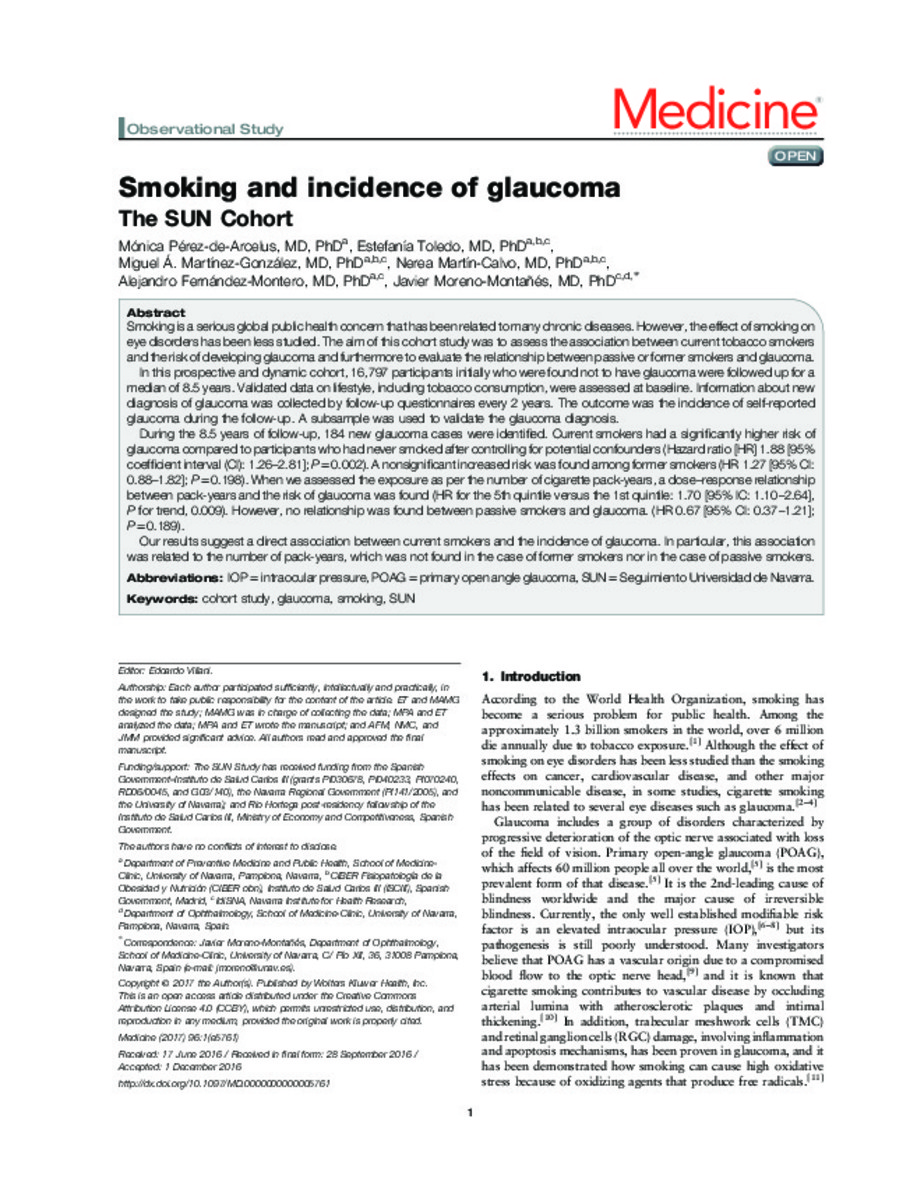Full metadata record
| DC Field | Value | Language |
|---|---|---|
| dc.creator | Moreno-Montañes, J. (Javier) | - |
| dc.creator | Fernandez-Montero, A. (Alejandro) | - |
| dc.creator | Martin-Calvo, N. (Nerea) | - |
| dc.creator | Martinez-Gonzalez, M.A. (Miguel Ángel) | - |
| dc.creator | Toledo, E. (Estefanía) | - |
| dc.creator | Perez-de-Arcelus, M. (Monica) | - |
| dc.date.accessioned | 2017-04-05T10:48:03Z | - |
| dc.date.available | 2017-04-05T10:48:03Z | - |
| dc.date.issued | 2017 | - |
| dc.identifier.citation | Perez-de-Arcelus M, Toledo E, Martinez Gonzalez M.A., Martin Calvo N, Fernandez Montero A., Moreno-Montañés J. Smoking and incidence of glaucoma The SUN Cohort. Medicine 2017 Jan;96(1):e5761. | es_ES |
| dc.identifier.issn | 0025-7974 | - |
| dc.identifier.uri | https://hdl.handle.net/10171/43227 | - |
| dc.description.abstract | Smoking is a serious global public health concern that has been related to many chronic diseases. However, the effect of smoking on eye disorders has been less studied. The aim of this cohort study was to assess the association between current tobacco smokers and the risk of developing glaucoma and furthermore to evaluate the relationship between passive or former smokers and glaucoma. In this prospective and dynamic cohort, 16,797 participants initially who were found not to have glaucoma were followed up for a median of 8.5 years. Validated data on lifestyle, including tobacco consumption, were assessed at baseline. Information about new diagnosis of glaucoma was collected by follow-up questionnaires every 2 years. The outcome was the incidence of self-reported glaucoma during the follow-up. A subsample was used to validate the glaucoma diagnosis. During the 8.5 years of follow-up, 184 new glaucoma cases were identified. Current smokers had a significantly higher risk of glaucoma compared to participants who had never smoked after controlling for potential confounders (Hazard ratio [HR] 1.88 [95% coefficient interval (CI): 1.26–2.81]; P=0.002). A nonsignificant increased risk was found among former smokers (HR 1.27 [95% CI: 0.88–1.82]; P=0.198). When we assessed the exposure as per the number of cigarette pack-years, a dose–response relationship between pack-years and the risk of glaucoma was found (HR for the 5th quintile versus the 1st quintile: 1.70 [95% IC: 1.10–2.64], P for trend, 0.009). However, no relationship was found between passive smokers and glaucoma. (HR 0.67 [95% CI: 0.37–1.21]; P=0.189). Our results suggest a direct association between current smokers and the incidence of glaucoma. In particular, this association was related to the number of pack-years, which was not found in the case of former smokers nor in the case of passive smokers. Abbreviations: IOP = intraocular pressure, POAG = primary open angle glaucoma, SUN = Seguimiento Universidad de Navarra. | es_ES |
| dc.language.iso | eng | es_ES |
| dc.publisher | Wolters Kluwer | es_ES |
| dc.rights | info:eu-repo/semantics/openAccess | es_ES |
| dc.subject | SUN | es_ES |
| dc.subject | Smoking | es_ES |
| dc.subject | Glaucoma | es_ES |
| dc.subject | Cohort study | es_ES |
| dc.subject | Materias Investigacion::Ciencias de la Salud::Salud pública | es_ES |
| dc.title | Smoking and incidence of glaucoma The SUN Cohort | es_ES |
| dc.type | info:eu-repo/semantics/article | es_ES |
| dc.description.note | Copyright ©2017 the Author(s). Published by Wolters Kluwer Health, Inc. This is an open access article distributed under the Creative Commons Attribution License 4.0 (CCBY), which permits unrestricted use, distribution, and reproduction in any medium, provided the original work is properly cited | es_ES |
| dc.description.note | Creative Commons Attribution License 4.0 (CCBY) | - |
| dc.identifier.doi | http://dx.doi.org/10.1097/MD.0000000000005761 | es_ES |
Files in This Item:
Statistics and impact
Items in Dadun are protected by copyright, with all rights reserved, unless otherwise indicated.






